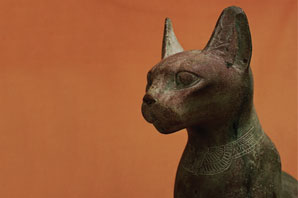The history of pets, part 1: Cats

Ever wondered how cats, dogs and rabbits came to share our homes and gardens? In the first of a three-part series for Petplan, writer and pet-lover Julian Hall looks at the history of cats...
If you sometimes marvel at how far your cat roams from home, then you'll be amazed at how far our treasured pusses (or 'felis catus' to be precise) have travelled in terms of their evolution.
Fossil evidence tells us that the first cat-like animals roamed the earth 35 million years ago - that's about 30 million years after dinosaurs became extinct. The first fossils resembling our present-day cats date back 12 million years, and the oldest evidence of cats and humans living side by side was discovered by archaeologists digging on the island of Cyprus, who dated their finds to 7500 BC.
But how and why did humans and cats begin to co-exist? The truth is, we're still not entirely sure.
FARMERS AND PHARAOHS
Evidence suggests that, 9,500 years ago, a type of wildcat began to inhabit human settlements in the Fertile Crescent - a stretch of agricultural land including Mesopotamia (present-day Iraq and surrounding areas) and parts of north Africa.
Stephen J O'Brien, one of the geneticists who published the research in 2007, said:
'One of nearly 40 wildcat species existing at that time, the little wildcat that lived in the Middle East had a genetic variance that allowed it to sort of try an experiment - let's walk in and see if we can get along with those people.'
So this might have been the first time cats ventured into farms to hunt rodents, kick-starting the gradual socialization of these curious wildcats. In time, a distinct group possibly took full advantage of the benefits of human settlements, such as the availability of food, shelter and protection from predators. At worst, farmers might have tolerated these cats; at best, encouraged them to guard the stores of grain upon which rodents fed.
More recent investigations suggest that the ancient Egyptians were the first to breed cats, several thousand years later. In 2012, scientists in California extracted DNA from the remains of animals offered as sacrifices to the gods during the time of the pharaohs. Their results indicated that the people of the time constructed large catteries where cats were bred for divine offerings.
CATS IN CULTURE
What we do know is that cats played a big part in ancient Egyptian culture, and can be seen in art dating back to 4000 BC. Cats that were not sacrificed earned a great living status and, when they died, were often mummified with their human owners.
At feline funerals, some owners and their family members would shave off their eyebrows to mark the occasion. In fact, cats were so important to the ancient Egyptians that anyone who killed a cat for a reason other than sacrifice could face punishment by death.
Cats spread into Europe and Asia with Egyptian shipping explorations and the expansion of the Roman Empire, but they did not always receive a warm welcome. During the Medieval era, some European societies (including in Britain) associated cats with witchcraft, and many were killed in attempts to ward off the devil.
In the Far East, they were better regarded. In Japan, cats were good-luck omens, and Islamic countries considered them symbols of purity. In fact, the prophet Mohammed was said to have preferred to go without his cloak than disturb a cat sitting on it!
MODERN MOGGIES
Nowadays, we spoil our feline friends rotten. Gourmet foods, all manner of toys and even beauty salons are among the myriad treats on offer. In fact, the range of cat food is staggering, with various specialist diets catering for pets with many different needs and preferences.
Of course, today's cats can also enjoy Petplan cover designed to help them enjoy a long and happy life. And while we may not be entirely sure when and how our relationship with cats began, long may it continue!
Look out for part 2 of our series later in the month, when we'll investigate the history of dogs. In the meantime, please let us know your thoughts on the history of cats below.

